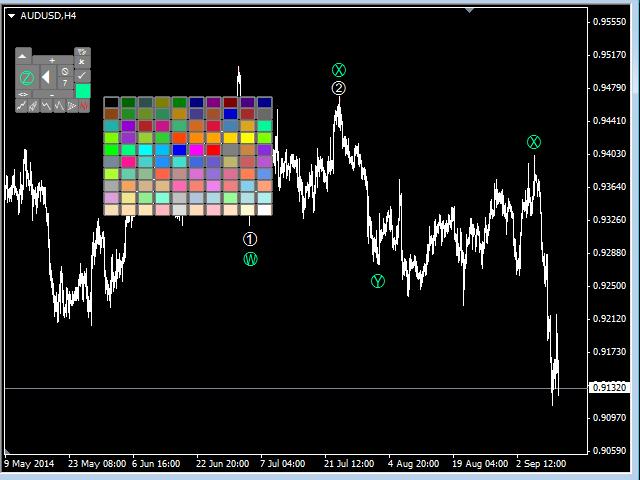This fresh Elliott Wave counting instrument is an improved variant of the ElliottWaveTool7pasos product .
The beginning of the new wave
To get started, click “<> “to indicate to the program that you intend to deselect any previous wave (if any).
set the type of pattern to compute. If you don’t have our free Elliott Wave Font, rather than the pattern icons, you may see the following letters on the buttons at the Type section: I=Impulse), D=Diagonal (Diagonal), Z=paned (Zigzag), F=horizontal (Flat), C=combination (combination) or a double zigzag. If needed, set the sub-pattern.
Set the scale (degree) and the instance by pressing the ” ” or ” – ” buttons on the panel.
Set the color (this will help you distinguish between alternative wave counts) by clicking on the corresponding color button.
The next wave that you are going to set is displayed on the “Add Wave” button(Add a wave). This is one of the largest buttons on the panel. Click on it when you’re ready.
If the wave starts a pattern, you will see the “Set Start” indication(Set the starting position) on the mouse cursor. Move the cursor to the desired bar, from which your wave starts. The selected bar is marked with a red line. If you place the mouse cursor under the bar, the price minimum (Low) will be used as the initial price. If you place the cursor over the bar, the price maximum (High) will be used as the initial price. Click when you’re ready.
[spoiler title=”Read More…”]
After setting the starting point of the wave, the first wave will appear under the cursor. It can be wave 1, A, or W, depending on the pattern you are calculating. In the same way, place the point to set the first wave. No matter how high or low you set your wave, the red line is used as the initial wave time. The price maximum (if you clicked above the bar) or minimum (if you clicked below the bar) is used as the initial price of your wave. The original price and time will be used to calculate projections for the next waves.
After setting the wave on the chart, you will immediately see the projections for the next wave. The next wave to calculate is displayed on the “Add Wave” button.
You can pause the wave calculation and switch to the calculation of another pattern by clicking the button “<> “anytime you don’t drag the wave.
To change the position of a wave, double-click on it as if you would like to select it. The wave will follow the mouse cursor. Install the wave to the new location in the same way as with a normal installation.
To cancel the installation, simply press Esc.
After setting the entire wave sequence for the selected pattern, the first wave is displayed again. If you add this wave by clicking on the “Add Wave” button again, a new pattern of a similar type will be calculated. You can set up to 100 identical patterns with the same color and instance.
Deleting the last wave
Click on one of the waves of the pattern, and then click on the button with a white triangle pointing to the left: the last wave of your pattern will be deleted. Press the button several times to reach the desired wave and remove it.
Changing parameters when the pattern waves are already set
To change any parameter of a pattern, simply click on any of its waves, and then click on any of the new parameters that you want to apply. For example, if you want to change the impulse pattern 1, 2, 3, 4 for the pattern W, X, Y, X, click on any of the waves, click the combination button and select the desired type of pattern. To combine, you can choose “DTZ “for double or triple zigzags or” DTC ” for double or triple combinations. After making the necessary changes, you will see how all the waves change taking into account the new pattern and new projections (when using them).
You can change the color, scale, and pattern at any time.
In the “Discussion” section, you will find instructions for the following functions:
- Removing all waves from the pattern at the same time
- Drawing projections for the next wave
- Hiding patterns from real and larger timeframes
- Minimizing the panel
- Moving the panel
- Clearing the chart
- Changing the font
- Adding / removing special symbols
- Interpretation of the Instance Number)
In the “Discussion” section, you will find instructions for the following functions:
- Removing all waves from the pattern at the same time
- Drawing projections for the next wave
- Hiding patterns from real and larger timeframes
- Minimizing the panel
- Moving the panel
- Clearing the chart
- Changing the font
- Adding / removing special symbols
- Interpretation of the Instance Number)
Elliott Wave Assistant is complemented by our PerfectLine. Check out the video below for a better understanding of how the product works.
[/spoiler]





